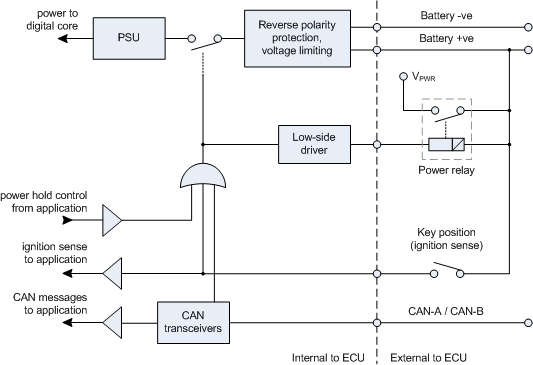ECU Power Control -- Ignition, Power hold, and Wake-on-CAN
Contents
The ECU internal power is switched based on several input signals. On most ECUs this is ignition and power hold.
Power hold can keep the ECU running even when the system ignition cycle has ended to perform final tasks such as updating nonvolatile memory.
Power Control configuration on ECU ''without'' Wake-on-CAN

The ECU is powered on whenever the ignition input is enabled (power must be applied to the VPWR pin).
- It is then powered off when the ignition is disabled.
The power hold channel can be controlled by the application as a digital output to keep the ECU on even after the ignition is turned off.
- When the power hold is enabled the ECU will remain on even after the ignition is disabled.
- The ECU will power down when both the ignition and power hold are disabled
It is recommended to keep the power hold enabled for the entire duration of the application in cases where the ignition signal may be faulty.
Check your target's Technical Specification for details specific to that target. This will tell you which pin is the ignition input and which channel to use for power hold.
Power Control configuration on ECU ''with'' Wake-on-CAN

The ECU with wake-on-CAN behaves similarly to ECUs without wake-on-CAN, but can be powered up by receiving a CAN message on a wake-enabled CAN bus.
- Any sensible CAN message on a CAN bus that supports wake-on-CAN will power up the ECU
The ECU application must assert the power hold immediately after the ECU is turned on. The ECU will remain active until the application deasserts the power hold.
Check your target's Technical Specification for details specific to that target. This will tell you which pin is the ignition input, which channel to use for power hold, whether wake-on-CAN is enabled for your target, and for which CAN busses.
